2) The 1970s-the mid-1990s: The Stage of Scientific Investigation and Excavation
With the continuous development and maturation of field archeology in Chinese Mainland and Taiwan, some field archaeologists began to turn the focus of their survey and investigation to islands and sandbars, including Nanhai Zhudao, in the ocean in order to protect the valuable marine cultural heritage of the motherland and safeguard its marine rights and interests. From the 1970s onwards, the archaeological work on Xisha Qundao entered the stage of purposeful and planned scientific investigation and excavation. However, underwater archeology in China was in the germination period in the 1980s, with inadequate talents, equipment and technology. Therefore, archaeological investigation of islands was primarily land-based field investigation and excavation.
(1) Two Surveys of Cultural Relics of Xisha Qundao in 1974, 1975
In 1974 and 1975 respectively, an archaeological team was jointly dispatched by Guangdong Provincial Museum and the Cultural Bureau of Hainan Administrative Region to Xisha Qundao for archeological investigation. From March to May 1974, the team launched its first heritage investigation, covering Shanhu Dao, Ganquan Dao, Jinyin Dao, Jinqing Dao, Chenhang Dao, Guangjin Dao, Quanfu Dao, Yongxing Dao, Zhaoshu Dao, and Beidao Dao. Trial archaeological excavation was conducted in Ganquan Dao and Jinyin Dao and some valuable information obtained.
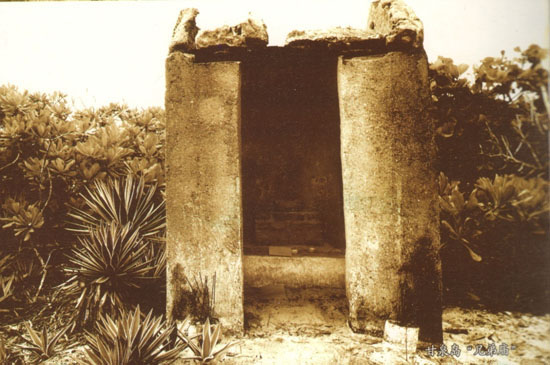
Xiongdi (Brotherhood) Temple on Ganquan Dao
Trial excavation on Ganquan Dao yielded the remains of a residence during the Tang and Song Dynasties. Among the 37 porcelain wares unearthed, 11 belonged to the Tang Dynasty, with celadon jar with four loop handles as the representative, similar to porcelain wares of the same shape unearthed from the Tomb of Zhang Jiuling in Shaoguan, Guangdong Province. The rest 26 pieces were from the Song Dynasty. Represented by Small-mouth Vase with Greenish White Glaze, spotted vase, spotted pot, jar with four loop handles, bowls, plates, powder boxes, they were the same as vessels of the same shape unearthed from the site of Huangdi Kiln in Guangzhou and that of Bijiashan Kiln in Chao’an. Their location in the accumulative stratum of the site, and company of wok pieces indicated that they had been the daily utensils of people living on the island.
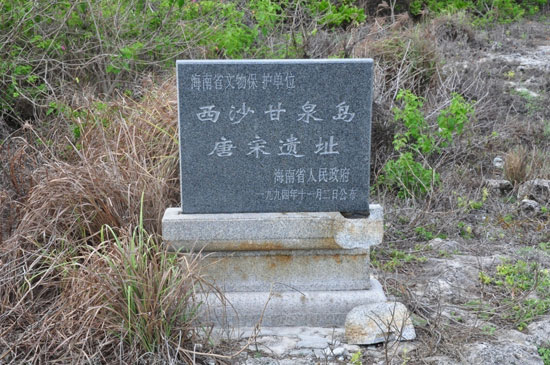
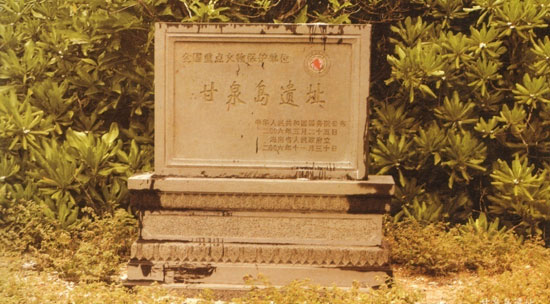
Cultural Relic Site on Ganquan Dao
Another important result of this survey is the discovery of a number of porcelain wares of the Song, Yuan, Ming and Qing Dynasties. On Yongxing Dao, Jinyin Dao and Beidao Dao, celadon plates with blue and white patterns and celadon plates with dragon patterns produced in private kilns of Jingdezhen in Jiangxi during the reign of Kangxi and Yongzheng in the Qing Dynasty were found. It is worth mentioning that more porcelain wares were found on the reef bases, mainly under Beijiao Jiao, Jinyin Dao and Quanfu Dao. Consisting of celadon porcelain pots and wash-wares of the Song Dynasty, Longquan Kiln porcelain plates of the Yuan Dynasty, celadon plates with dragon and phoenix patterns of Jiajing Era of the Ming Dynasty, celadon bowls and plates of Dehua Kiln produced in Daoguang Era of the Qing Dynasty, those porcelains were produced in kilns in south China. Mostly export-oriented, they were probably left behind by merchants and fishermen visiting Xisha Qundao.
During this survey, efforts were also focused on sorting out the relics of a Ming-Dynasty shipwreck salvaged by fishermen of Caotang Branch, Tanmen Commune, Qionghai County. Lodged in the reef base in the northeastern corner of Beijiao Jiao, the wreck yielded over 500 kilograms of ancient coins and copper ingots, bronze mirrors, copper scabbards and lead ingots after three salvages in 1961, 1971 and 1974 respectively. Over 30 kinds had inscriptions readily intelligible. The coins cover a wide range of time and a rich variety, spanning from the years of Wang Mang in the Han Dynasty to the Yongle Era in the Han Dynasty. Featuring Yongle Tongbao, the coin of Yongle Era, they include cast by the central government and the rebelling farmers’ army. Some of those coins cast in the late Yuan Dynasty and early Ming Dynasty saw circulation mainly in the Yangtze River. The latest "Yongle Tongbao’s coins" were mostly new; therefore, it is speculated that the ship must have belonged to the fleet of Zheng He starting from Jiangsu.
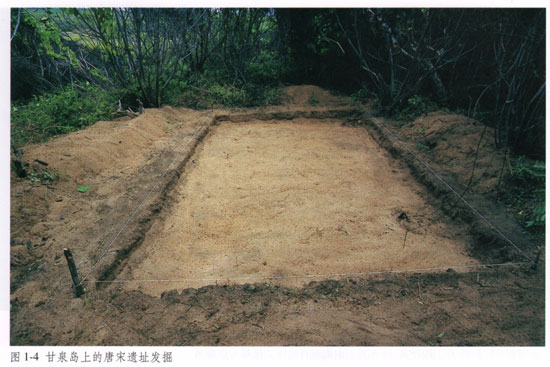
Excavation of Tang- and Song-Dynasty Relics on Ganquan Dao
Small temples found on some of the islands and sandbars were within the scope of the survey. The 13 post-Ming temples recorded can be divided into two types, i.e., those built with several large coral slates and those consisting of square single rooms built with coral rocks. In the temple on the northwestern corner of Chenhang Dao, a statue of Avalokitesvara of Longquan Kiln in the Ming Dynasty was enshrined, while two celadon porcelain basins of Dehua Kiln in the Daoguang Era of the Qing Dynasty were found in the small temple on Beidao Dao.
In addition, four inscribed stone monuments were found during this survey. Two of those were dated back to the twenty-eighth year of the reign of Emperor Guangxu (1922) in the Qing Dynasty. Broken and scattered around the corral temple and the thatched fishermen’s hut in the eastern corner of the Island, they bore the inscriptions to the effect of "in commemoration of the inspection in the eighth year of Guangxu in the Qing Dynasty" and "in commemoration of the inspection in the twenty-eighth year of Guangxu in the Qing Dynasty" respectively. The other two steles were found on Yongxing Dao. One of them had been erected by the National Government in 1921, bearing the inscription "inspection commemoration." The other one, erected on November 24, 1946 by the National Government when it recovered Xisha Qundao, bore the inscription of "barrier of the South China Sea" on one side and "in commemoration of the recovery of Xisha Qundao by the Navy" on the other.
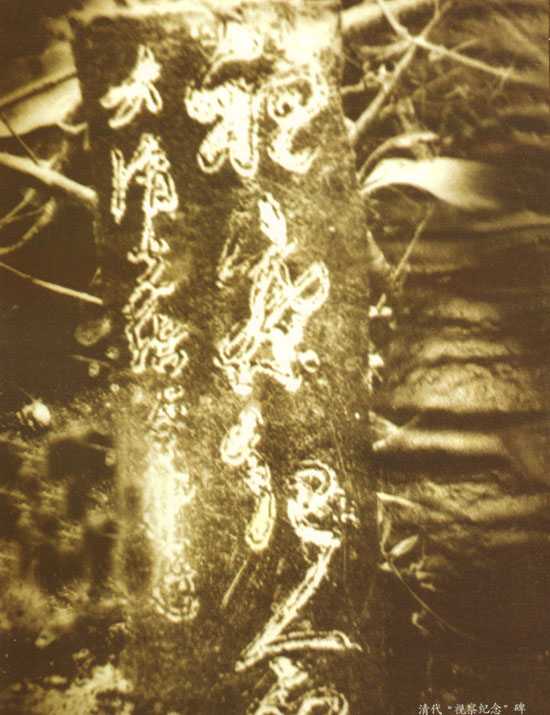
Qing-Dynasty "Stele Commemorative of the Inspection"
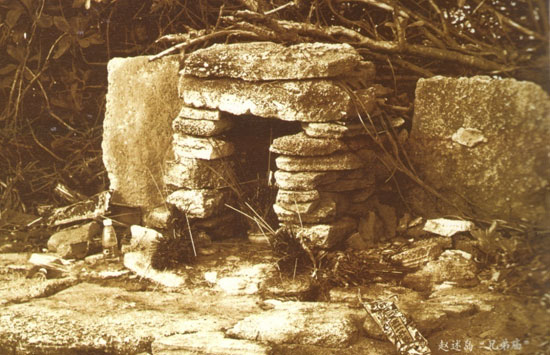
Brotherhood Temple on Zhaoshu Dao
From March to April 1975, Guangdong Provincial Museum and the Cultural Bureau of Hainan Administrative Region launched the second investigative excavation in Xisha Qundao, focusing on re-exploring the Tang- and Song-Dynasty sites on Ganquan Dao. Located on a slope on one side of the island, the site had a cultural layer of 20 to 55 cm in thickness. The yields of excavation were mainly porcelain wares, of which celadon pot with two ears, melon-shaped bottles, small-mouth vases, spotted vases, powder boxes, flared-rim wine cups, flared-rim bowls, wide-rim bowls, bowls with lotus patterns, bowls with comb patterns, and bowls with lotus petal patterns were readily discernible, and metal utensils, including iron knifes, iron chisels, and bronze accessories. In addition, a large number of bird bones and snail shells were unearthed. The relics unearthed were similar to those of the same shapes and era unearthed in the coastal regions of Guangdong and Fujian in the Tang and Song Dynasties. They were determined to be artifacts of the Tang Dynasty at the earliest and the Northern Song Dynasty at the latest.
Another major achievement of the second survey was the thousands of pieces of porcelain specimens collected from more than ten islands, sandbars and reefs. Among those, the important ones include: the celadon six-ear pot and the celadon cup of the Southern Dynasties (similar to vessels of the same category and era unearthed in Shaoguan and Yingde) collected from Beijiao Jiao;the small celadon pot lid of Jingdezhen in the Yuan Dynasty; green-glazed and celadon porcelain wares from the Tang Dynasty to the Ming Dynasty and the Song-Dynasty dinner plates with inscribed lines collected from Quanfu Dao; both of those had been produced in Fujian; Ming-Dynasty celadon bowls bearing the inscriptions of "Made during the Xuande Years" and "Made during the Jiajing Years" from Beidao Dao; celadon colored pot, celadon vase with landscape patterns and celadon pot lids produced by private kilns in Jingdezhen in the early Qing Dynasty found on Hewu Dao; celadon porcelain disk with colored patterns of private kiln in Jingdezhen during the reign of Emperor Kangxi jin the Qing Dynasty from Yongxing Dao; Qing-Dynasty celadon bowls inscribed with "Citang Ruixing" and "Citang Dezhai" in the center (believed to be closely related to "Citang Ruizhen" porcelain wares unearthed in the vicinity of Nanputuo Temple in Fujian) from Shanhu Dao; imitated celadon wares with inscription of "Made in the Chenghua Years" and celadon bowls and plates of Dehua Kiln produced in the reigns of Emperor Jiaqing and Daoguang in the Qing Dynasty, found on Nansha Zhou. On those porcelain wares such patterns as flowers, riverside pavilions, elaborate cornices and doorsteps and sailing boats and inscribed with the verse of "In the morning, the richly painted beams usher in the cloud from Nanfu; at dusk, the bead curtain welcome the rain from the Xishan Mountain" by Wang Bo of the Tang poet (the same as those on porcelain wares collected from Pingyuan, Guangdong). Celadon bowls and plates of Dehua Kiln produced in the reigns of Emperor Jiaqing and Daoguang in the Qing Dynasty; Song-Dynasty celadon bowls produced in Fujian from Nandao Dao; Dehua-Kiln celadon bowels with cloud and phoenix patterns and cloud and dragon patterns and late-Qing celadon bowls with inscriptions.
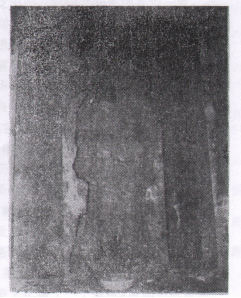
Jinsha Temple on Jinyin Dao and the Deity Enshrined
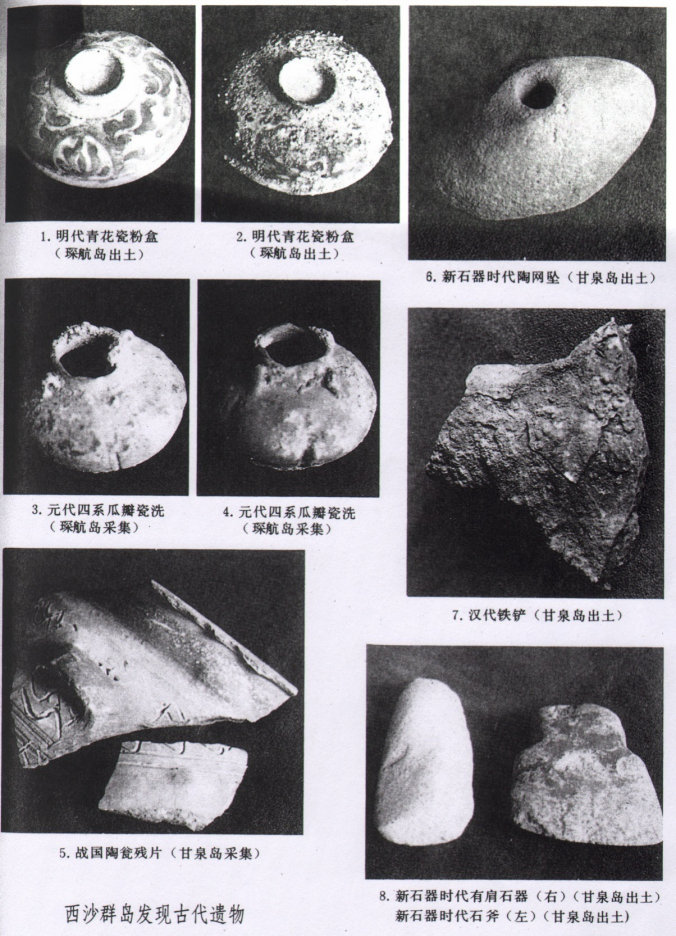
Ancient Relics Discovered on Xisha Qundao
Other important discoveries were also made. For example, coins of and before the Ming Dynasty carried on wrecked ship of Zheng He’s fleet. Found on Beijiao Jiao, they included Banliang of the Qin Dynasty, Kaiyuan Tongbao of the Tang Dynasty, Taiping Tongbao of the Northern Song Dynasty, Jianyan Tongbao of the Southern Song Dynasty, Zhenglong Yuanbao of the Jin Dynasty, Zhida Tongbao, Dayi Tongbao and Dazhong Tongbao of the Yuan Dynasty, and Hongwu Tongbao and Yongle Tongbao of the Ming Dynasty. Qing-Dynasty temple structures found on Jinyin Dao including stone carvings, stone lions, stone columns, stone ridges, stone cornices, stone mill and stone pedestals for sacrificial vessels.
The archaeological investigation and excavation efforts of Xisha Qundao show that in the Southern Dynasties at the latest, residents of Chinese Guangdong have already sailed to the sea. Daily utensils left on Beijiao Jiao were left by them. Between the Tang Dynasty and the Song Dynasty, Ganquan Dao was inhabited by permanent residents, who used the same living appliances as the residents of Guangdong and were engaged in hunting and fishing.
(2) Survey of Xisha Qundao by Wang Hengjie in 1991
A professor of Minzu University of China, Wang Hengjie is a respected archeologist of frontier history, with special contributions to the history, archeology and survey of Nanhai Zhudao. From May to June, 1991, he launched a survey of Yongxing Dao, Shidao Dao, Zhongjian Dao, Chenhang Dao, Guangjin Dao, Jinyin Dao, Ganquan Dao and Shanhu Dao, as well as the adjacent beaches and reef bases.
The most important finding of this survey is the discovery of prehistoric relics—a brown ceramic coffin composed of three sleeved urns—at the northwest end of Jinyin Dao. Interned close to the surface of the earth, the three ceramic urns had been damaged beyond repair because of frequent modern activities. Near the coffin, one brown pottery steamer with sand sleeve and one grinding mill with stone shoulder devices were found. In addition, one trapezoidal stone ax, one small stone ground ax and one clay pottery bob-weight for fishing net were found. These relics were dated back to the late Neolithic period, with the same cultural connotations as similar heritage unearthed in the southeastern coastal areas of China, especially in Hainan. Three urns sleeved for coffin were also found in Lingshui, Hainan.
The relics dated between the Warring States Period and the Han Dynasty on Ganquan Dao were other important findings of this investigation. Mainly consisting of fragments of urns with horizontal ears and bowstring and ripple patterns, they had the same texture and patterns as pottery wares unearthed from the tombs of the Warring States Period in Tonggu Ridge, Guangning County, Guangdong Province. In addition, there were fragments of other clay utensils, including the pottery urn with the Union Jack pattern and orange clay pot with bowstring patterns. Those fragments were similar to pottery with pressed patterns unearthed in the Pearl River Delta of Guangdong and Hainan. Besides, one seriously corroded Han-Dynasty scrap iron shovel was also found. Aside from cultural relics found on Ganquan Dao, a number of ceramic specimens dated between the Wei and Jin Dynasties and Ming and Qing Dynasties were discovered.
(3) Heritage Survey of Xisha Qundao in 1996
From April to May 1996, onshore and underwater surveys of 18 islands, 4 sandbanks and 4 atolls, which all belong to Xisha Qundao, were implemented by an expedition team. About 1,300 pieces of cultural relics were discovered in 15 of the islands and 3 of the sandbanks and most of them were porcelain wares. It is worth noting that the survey encompassed Zhongdao Islands, Zhongshazhou Sandbar and Xishazhou Sandbar, which had never been studied before. In addition, underwater archaeological survey was conducted for Beijiao Jiao, Langhua Jiao, Huaguang Jiao, Lingyang Jiao, and the waters adjacent to Shanhu Dao and Jinyin Dao, and 8 spots of cultural relics were found and about 500 ancient artifacts were salvaged. This survey constituted the preparatory efforts for large-scale underwater archaeological in the future.
Of the specimens obtained in the survey, the celadon vials of Shanhu Dao, the porcelain plate with carved flower patterns and the green-glaze wine pot were similar to those unearthed in the site of the Song-Dynasty kiln in Huangdi Ridge, Xicun Village, Guangzhou. The green-glaze wash ware with double-fish pattern, ring-footed plates and other vessels salvaged from the seabed at Beijiao Jiao were products of Longuan Kiln in the Yuan Dynasty. The Qing-Dynasty celadon porcelain wares found in Nanshazhou were produced in Guangdong area, Dehua Kiln in Fujian and private kiln of Jingdezhen in Jiangxi.







 Overview
Overview Resources & Environment
Resources & Environment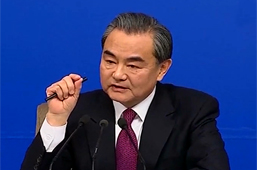


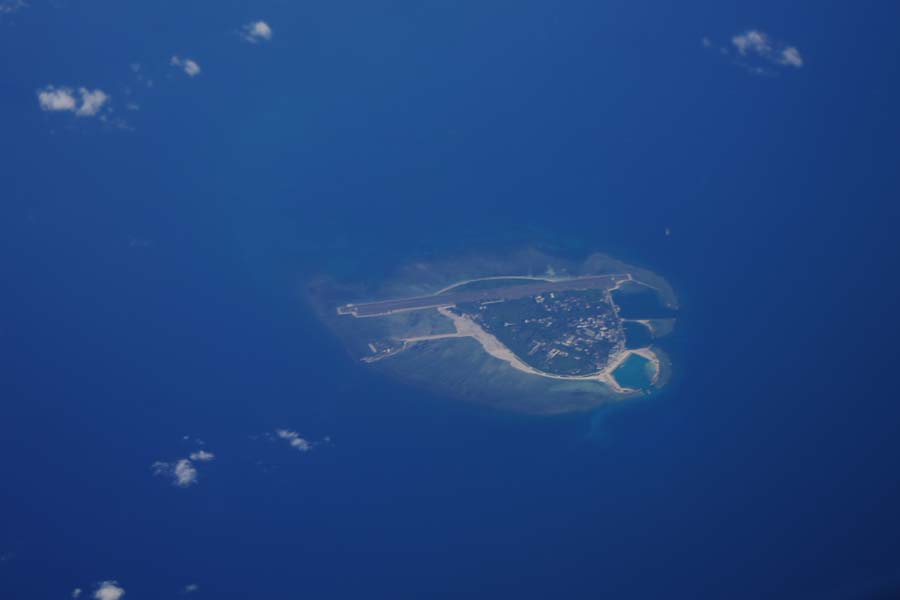
 QQ 好友
QQ 好友 微信好友
微信好友 易信好友
易信好友 QQ空间
QQ空间 朋友圈
朋友圈 百度空间
百度空间